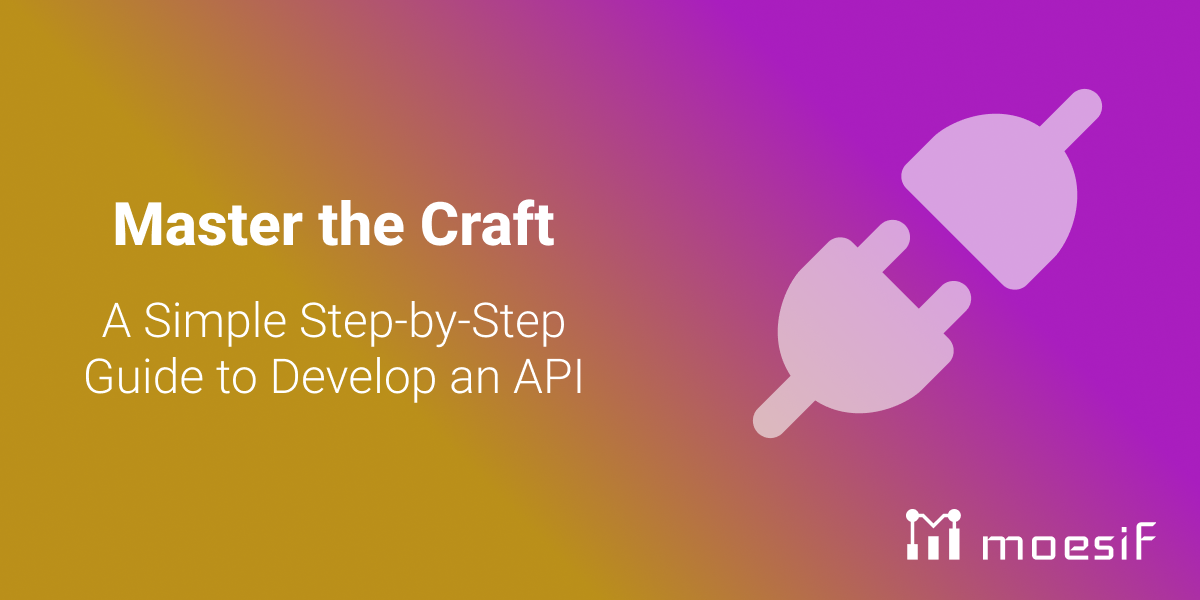Master the Craft: A Simple Step-by-Step Guide to Develop an API

This guide simplifies API development, walking you through every step from idea to working product. Learn to plan, design, and build a reliable, secure API. Get practical advice on understanding your users, creating a scalable infrastructure, and documenting your API for easy use and maintenance. Thorough API documentation is crucial for public APIs, as it significantly impacts adoption rates. We’ll also cover API integration.
API development is not just about writing code; it’s about creating a seamless bridge between different software components, enabling them to communicate effectively. This guide will provide insights into choosing the right tools and technologies that best fit your project requirements. From selecting the appropriate programming language to understanding the nuances of RESTful and SOAP APIs, we aim to equip you with the knowledge to make informed decisions.
Key Takeaways
- API development is a structured process that includes requirement conception, design, implementation, testing, documentation, deployment, and performance monitoring.
- The planning and design phases of API development are crucial, involving the selection of API goals, defining functional and non-functional requirements, choosing an architectural style, and ensuring robust API security.
- Proper API monitoring and optimization post-deployment are vital. To maintain API health and user satisfaction, performance metrics must be tracked, user feedback incorporated, continuous improvement loops implemented, and API versioning managed effectively.
- Understanding and handling API requests and responses is essential. This includes testing the behavior of endpoints after receiving API requests like GET, PUT, DELETE, HEAD, and PATCH, and optimizing API responses for performance, including implementing pagination and search functionality.

Understanding API Development
In web development, APIs are the bridges connecting different software components. Building effective APIs involves a series of key steps.
- The initial conception of requirements
- This involves understanding the user’s needs and what the API aims to achieve. It’s the stage where you define the scope and purpose of your API.
- Designing the API architecture
- Here, you select the protocols and standards your API will adhere to. You determine how the API will be structured, the data formats it will use, and how it will handle different requests. Considerations for designing the API interface include using service description languages like OAS, Swagger, and RAML to ensure both machines and humans can understand the API functionality.
- Implementing the API endpoints
- You write the actual code for the API’s functionalities at this stage. This includes setting up the endpoints that will handle requests and defining the actions that will be taken when these endpoints are accessed.
- Testing and debugging
- Before going live, the API must be rigorously tested. This involves running various test cases to find and fix bugs, ensuring the API behaves as expected under different conditions.
- Documenting the API
- Good documentation is crucial for any API. It guides developers on effectively using the API and includes information on endpoints, parameters, data formats, and error codes.
- Deploying the API
- Once the API is tested and documented, it’s time to deploy it to a server where users can access it. This might involve setting up a scalable infrastructure to handle the load.
- Monitoring performance
- After deployment, monitoring the API to ensure it’s performing well and quickly identifying any issues is important. This includes tracking uptime, response times, and usage patterns.
The API lifecycle is integral to this process, ensuring that each stage is meticulously planned and executed. The journey from blueprint to launch can be seamless or prolonged, tailored to the complexity of the task. The API culminates in its publication, making the source code available to developers.
Application Programming Interface (API) Basics
APIs are the backbone of data flow and functionality across various platforms. They enable communication through their interface, with each endpoint acting as a specific access point. REST APIs, known for their simplicity and scalability, are ideal for streamlined interactions. SOAP APIs, using XML, cater to complex transactions with intricate data structures. Choosing between REST and SOAP depends on the desired level of intricacy for your specific application.
HTTP methods are crucial in defining the types of requests an API endpoint can receive. Common methods include GET, PUT, DELETE, HEAD, and PATCH, each mapping to specific actions in the context of an HTTP API and RESTful URLs.
Key Components in API Development
A well-structured API simplifies digital development. Built on architectural design, security, and comprehensive documentation, it guides developers toward seamless integration. Meticulously crafted API keys and planned responses create a robust API server. Effective API key management is crucial for system security and efficiency. An API description plays a vital role in creating and managing APIs, potentially using an uploaded API description file.
Planning Your API: Goals and Requirements
Building an API requires careful planning. It begins with understanding the audience, defining clear objectives, and considering technical constraints. A well-thought-out plan, prioritizing scalability and security, lays the groundwork for a successful API. Developing your own API involves an iterative process, building one endpoint at a time, gradually adding functionalities, and ensuring thorough testing.
Identifying API Goals
The journey to create a successful API starts with aligning its goals with broader business objectives.
- Storytelling through data exchanges
- Crafting experiences that resonate with the users
- Presenting information in a way that augments engagement and innovation.
Whether the API’s purpose is to generate revenue, provide tools for internal teams, or enhance customer satisfaction, its objectives should always align with the broader goals of the organization. Understanding the differences between private and public APIs is crucial; private APIs are intended for internal use and require different documentation and audience considerations compared to public APIs, which need high-quality documentation for external users.
Defining Functional and Non-Functional Requirements
The core of an API’s design involves defining its functions, data formats, and capabilities. Beyond these core elements, non-functional requirements are essential for ensuring the API’s performance, reliability, and security. They guarantee error handling, responsiveness, and efficient data processing, maintaining the API’s quality across platforms and languages.
Designing Your API: Structure and Security
API architecture should prioritize usability and security. A consistent architecture fosters developer confidence and understanding. Beyond structure, strong security measures are essential to protect against vulnerabilities, ensuring secure transactions. Standardizing API responses, including the implementation of pagination and search functionality to handle large datasets, is crucial for efficient data management.
Selecting an Architectural Style
Selecting an architectural style and API design is a declaration of the one creating an API’s identity. It can be:
- REST, with its stateless interactions and cacheable data
- GraphQL, catering to precise data queries
- Microservices, segmenting the API into a well-defined ecosystem of services, each operating independently
The choice reflects the essence of the API’s identity, mirroring its unique needs and aspirations.
Ensuring API Security
The API gateway serves as the API’s security checkpoint, verifying every request to ensure only authorized access and protect data integrity. It also regulates traffic, safeguarding the API from overload and malicious attacks. These measures demonstrate a robust commitment to API security.
Developing and Implementing Your API
API endpoint development is an iterative process, starting with requirements and evolving through structured endpoints and responses. Defining the actions that will be taken when these endpoints are accessed is crucial. It is important to handle different types of API requests, such as GET, PUT, DELETE, HEAD, and PATCH, and to test their behavior. Continuous integration, testing, and version control ensure the API’s compatibility and reliability over time.
Choosing a Preferred Programming Language
API development hinges on choosing the right programming language and framework, as these choices impact performance, maintainability, and overall capability.
- Python, favored for its rapid application development
- Java, known for its robustness
- JavaScript, widely used for web development
- Ruby, known for its simplicity and readability
- PHP, commonly used for web development
- C#, used for Windows development
- Go, known for its efficiency and scalability
Developers may call upon these languages (and many others) to bring their APIs to life.
Each programming language, with its unique strengths and community support, can easily transform ideas into functional digital realities.
Writing and Testing Code
Writing API code requires a blend of creativity and precision. Testing, including unit and integration tests, becomes crucial to ensure the API functions as intended.
Every test polishes the API for its big launch. Beyond the initial testing phase, continuous testing and monitoring are essential to maintain the API’s reliability and performance. This involves stress testing to evaluate how the API handles high traffic loads, security testing to identify and mitigate vulnerabilities, and performance testing to ensure optimal response times. Automated testing tools can streamline this process, allowing for regular and consistent checks without manual intervention. Additionally, incorporating feedback from early adopters can provide real-world insights into potential issues and areas for improvement, further refining the API before its official release.
Monitoring and Optimizing API Performance
Monitoring is crucial for tracking the API’s performance and ensuring it consistently meets user and business needs. Tools like Postman Monitoring, Amazon CloudWatch, and Moesif’s API analytics platform offer valuable insights into API usage patterns, error rates, and performance metrics. Moesif, specifically, provides a comprehensive view of how users interact with your API, allowing for data-driven optimizations and proactive issue resolution.
Moesif steers your API to excellence
Moesif goes beyond monitoring API metrics like performance and response times. It proactively sets up automated tests to ensure your API consistently delivers peak performance. Additionally, Moesif provides intuitive alerts and dashboards to guide you through traffic fluctuations and evolving usage patterns, ensuring the API remains dependable for all users.
Incorporating User Feedback
User feedback is crucial for the ongoing improvement of an API. By analyzing usage patterns and real-world data, developers gain valuable insights to refine and enhance the API. Changes are then implemented strategically, ensuring a positive user experience while maintaining functionality.
Summary
We’ve completed our API journey, covering the entire process, from start to continuous improvement. Whether it’s your first or fiftieth API, remember that creating something remarkable requires intention, innovation, and reflection.
As you start your project, keep in mind that an API is a dynamic entity that grows with your business. It needs ongoing nurturing through thoughtful planning, robust security, and careful design choices. Actively seek feedback from users and use it to refine and enhance your API. Be adaptable and evolve with the ever-changing technology landscape.
Organizations looking for the best tools to support their API management can leverage Moesif’s powerful API analytics and monetization capabilities. Moesif easily integrates with your favorite API management platform or API gateway through one of our easy-to-use plugins, or embed Moesif directly into your API code using one of our SDKs. To try it yourself, sign up today and start with a 14-day free trial; no credit card is required.
Remember, API development is a continuous journey of refinement. By staying dedicated and forward-thinking, your API will not just meet but exceed expectations, becoming a valuable asset in the digital world. Here’s to your success in API development!






